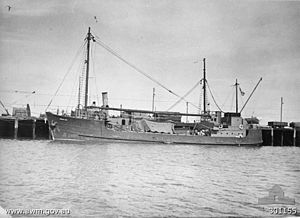This article relies largely or entirely on a single source. (September 2014) |
HMAS Patricia Cam was an auxiliary vessel operated by the Royal Australian Navy during World War II. She was sunk by a Japanese aircraft in 1943.
 Patricia Cam prior to entering military service
| |
| History | |
|---|---|
| Owner | Cam & Sons Pty Ltd |
| Builder | G. Beattie, Brisbane Waters, New South Wales |
| Fate | Requisitioned by RAN |
| History | |
| Acquired | 9 February 1942 |
| Commissioned | 3 March 1942 |
| Honours and awards |
|
| Fate | Sunk, 22 January 1943 |
| General characteristics in RAN service | |
| Type | Fishing vessel |
| Displacement | 301 tons |
| Length | 120 ft 9 in (36.80 m) |
| Beam | 30 ft 3 in (9.22 m) |
| Draught | 6 ft 4 in (1.93 m) |
| Propulsion | diesel engines, 160 HP |
| Speed | 8 knots (15 km/h; 9.2 mph) |
| Complement | 2 officers, 17 ratings |
| Armament |
|
Construction
editThe ship was built in 1940 at Brisbane Waters, New South Wales as a tuna-fishing trawler for the Sydney fishing company Cam & Sons Pty Ltd.[1]
Operational history
editFollowing the outbreak of war in the Pacific, the ship was requisitioned by the Royal Australian Navy for use as an auxiliary minesweeper on 9 February 1942.[1] She was commissioned into the RAN on 3 March 1942 as HMAS Patricia Cam, with a complement of 2 officers and 17 sailors.[1]
Based in Darwin, Patricia Cam was mainly used to transport supplies to small communities, military outposts, and Coastwatchers.[2]
Loss
editIn January 1943, the vessel sailed through the islands off Arnhem Land.[2] At one stop, they picked up six passengers: five Yolngu Aborigines including Narritjin Maymuru, and Reverend Leonard Kentish, chief of the Methodist mission stations in the Northern Territory.[2] Patricia Cam then sailed for the Wessel Islands.[2]
On 22 January, while en route, a Japanese floatplane located Patricia Cam and attacked; the unaware vessel had no radar.[2] The first bomb landed in Patricia Cam's hold and exploded, killing one sailor.[2] The damage caused the ship to sink within a minute.[2] A second bomb from the floatplane killed another sailor and two of the passengers.[2] The floatplane made several strafing runs, then landed near the survivors.[2] After failing to encourage the survivors to surrender, one of the crew captured Kentish at gunpoint (the only Australian prisoner-of-war captured inside Australian territory) and left.[2] Kentish was flown to Dobo in the Aru Islands where he was interrogated, including the frequent use of beatings, for several weeks, before being executed by his captors on or about 4 May.[3]
All but two of the remaining survivors were on a liferaft.[2] The others were clinging to debris, and drifted away; the remains of one were found nine years later in a cave on Valencia Island, 320 kilometres (200 mi) from the point of sinking.[2] The life raft drifted for 15 hours before coming to an islet off Guluwuru.[2] The survivors swam ashore and fell asleep on the beach, waking to find that one of the crew had died from his wounds during the night.[2] One of the passengers died the next day, with both bodies buried on the beach.[2] Fires lit by the survivors were spotted by natives of the Wessel Islands, who came across in canoes to render assistance.[2] Two groups left to find help, one group of natives paddling south, the other leading Patricia's captain to the Marchinbar Island radar station.[2] Supplies were dropped to the survivors by an RAAF reconnaissance plane, and they were rescued on 29 January by HMAS Kuru.[2]
The vessel's military service was later recognised with the battle honour "Darwin 1942–43".[4][5]
References
edit- ^ a b c Bastock, John (1975). Australia's Ships of War. Cremorne, NSW: Angus and Robertson. p. 233. ISBN 0207129274. OCLC 2525523.
- ^ a b c d e f g h i j k l m n o p q r Clausen, Lisa (15 March 2014). "'I want him home'". The Sydney Morning Herald. Retrieved 21 March 2014.
- ^ "War Crimes". Australia's War 1939–1945. Department of Veterans Affairs. Archived from the original on 27 July 2008. Retrieved 21 March 2014.
- ^ "Navy Marks 109th Birthday With Historic Changes To Battle Honours". Royal Australian Navy. 1 March 2010. Archived from the original on 13 June 2011. Retrieved 23 December 2012.
- ^ "Royal Australian Navy Ship/Unit Battle Honours" (PDF). Royal Australian Navy. 1 March 2010. Archived from the original (PDF) on 14 June 2011. Retrieved 23 December 2012.
External links
edit- "HMAS Patricia Cam". Royal Australian Navy. Retrieved 14 December 2008.